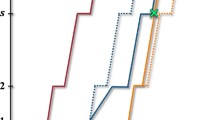Abstract
In high frequency bus service lines buses often come irregularly at the stops, often in bunches, due to the uncertainty of the passenger demand and behavior and unexpected conditions on the roads. Vehicle holding is a commonly used strategy among a variety of control strategies in transit operation in order to reduce bus bunching and regulate bus headways. This paper investigates a control strategy of holding a group of buses at a single or multiple control point(s). By incorporating any passenger boarding activities during holding, a single control point problem is developed and extended to multiple control points to reduce the variance of headways for the downstream stops. The problem is a non-convex optimization problem with linear constraints that minimizes the total passenger waiting time both on-board and at stops. A heuristic is then developed that is easy and fast to implement, which makes it suitable for real-time implementation. The model is evaluated with a simulation case study by using the real-time bus operation data (i.e., Automatic Vehicle Location and Automatic Passenger Count Data) from the Chicago Transit Authority (CTA). The simulation results show that considering the boarding activities in the total waiting time, our model mitigates the error propagation and maintains steady performance, compared to the common models in the literature, which do not consider boarding while holding.





Similar content being viewed by others
Notes
It is interesting to note that in 2009, the CTA had a slight drop in bus bunching down to 2.5 % due to budget cuts which resulted in less frequent service.
The parameters were derived from real time bus route operation data provided by the CTA.
Transit Capacity and Quality of Service Manual, 2nd Ed.
References
Abkowitz M, Engelstein I (1984) Methods for maintaining transit service regularity. Transp Res Rec 961:1–8
Abkowitz M, Lepofsky M (1990) Implementing headway-based reliability control on transit routes. J Transp Eng 1(7):49–63
Abkowitz M, Tozzi T (1986) Transit route characteristics and headway-based reliability control. Transp Res Rec 1078:11–16
Barnett A (1974) On controlling randomness in transit operations. Transp Sci 8(2):102–116
Bellei G, Gkoumas K (2009) Threshold- and information-based holding at multiple stops. Intell Transp Syst J 3(3):304–313
Bellei G, Gkoumas K (2010) Transit vehicles’ headway distribution and service irregularity. Public Transp 2(4):269–289
Cortes CE, Saez D, Milla F, Munez A, Riquelme M (2010) Hybrid predictive control for real-time optimization of public transport system’s operations based on evolutionary multi-objective optimization. Transp Res, Part C, Emerg Technol 18(5):757–769
CTAPerformance Metrics (2011) Available at http://www.transitchicago.com/assets/1/performance_metrics/CTA_Company_Wide_KPI_Dec_11.pdf. Last accessed on Jan 5, 2012
Daganzo CF (2009) A headway-based approach to eliminate bus bunching: systematic analysis and comparisons. Transp Res, Part B, Methodol 43:913–921
Delgado F, Muñoz JC, Giesen R, Cipriano A (2009) Real-time control of buses in a transit corridor based on vehicle holding and boarding limits. Transp Res Rec 2090:59–67
Delgado F, Muñoz JC, Giesen R (2012) How much can holding and/or limiting boarding improve transit performance? Transp Res, Part B, Methodol 46:1202–1217
Ding Y, Chien S (2001) Improving transit service quality and headway regularity with real time control. Transp Res Rec 1760:160–171
Eberlein XJ, Wilson NHM, Bernstein D (2001) The holding problem with real-time information available. Transp Sci 35(1):1–18
Fu L, Yang X (2002) Design and implementation of bus-holding control strategies with real-time information. Transp Res Rec 1791:6–12
Fu L, Liu Q, Kalamai P (2003) Real-time optimization model for dynamic scheduling of transit operations. Transp Res Rec 1857:48–55
Herman R, Lam T (1974) Trip characteristics of journeys to and from work. In: Transportation and traffic theory, proceedings of the sixth international symposium on transportation and traffic theory. Elsevier, New York
Hickman M (2001) An analytical stochastic model for the transit vehicle holding problem. Transp Sci 35(3):215–237
Lin J, Ruan M (2009) Probability-based bus headway regularity measure. Intell Transp Syst 3(4):400–408
O’Dell S, Wilson NHM (1999) Optimal real-time control strategies for rail transit operations during disruption. In: Computer aided systems in public transport. Lecture notes in economics and mathematical systems, vol 471, pp 299–323
Oort NV, Wilson NHM, Nes RV (2010) Reliability improvement in short headway transit services. Transp Res Rec 2143:67–76
Oort NV, Boterman JW, Nes RV (2012) The impact of scheduling on service reliability: trip-time determination and holding points in long-headway services. Public Transp 4:39–56
Puong A, Wilson NHM (2008) A train holding model for urban rail transit systems. In: Computer aided systems in public transport. Lecture notes in economics and mathematical systems, vol 600, pp 319–337
Shen S, Wilson NHM (2001) An optimal integrated real-time disruption control model for rail transit systems. In: Computer-aided scheduling of public transport. Lecture notes in economics and mathematical systems, vol 505, pp 335–363
Sun A, Hickman M (2008) The holding problem at multiple holding stations. In: Computer-aided systems in public transport, vol 600, pp 339–359. Part III
Toledo T, Cats O, Burghout W, Koutsopoulos HN (2010) Mesoscopic simulation for transit operations. Transp Res, Part C, Emerg Technol 18(6):896–908
Turner JK, Wardrop JG (1951) The variation of journey time in central London. Road Research Laboratory Note No. RN/1511/JKT.JGW
Turnquist MA (1981) Strategies for improving reliability of bus transit service. Transp Res Rec 818:7–13
Welding PI (1957) The instability of a close-interval service. Oper Res Q 8(3):133–142
Xuan Y, Argote J, Daganzo CF (2011) Dynamic bus holding strategies for schedule reliability: optimal linear control and performance analysis. Transp Res, Part B, Methodol 45:1831–1845
Author information
Authors and Affiliations
Corresponding author
Rights and permissions
About this article
Cite this article
Chen, Q., Adida, E. & Lin, J. Implementation of an iterative headway-based bus holding strategy with real-time information. Public Transp 4, 165–186 (2013). https://doi.org/10.1007/s12469-012-0057-1
Published:
Issue Date:
DOI: https://doi.org/10.1007/s12469-012-0057-1




